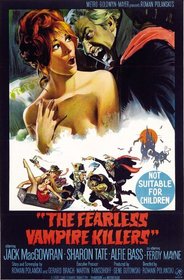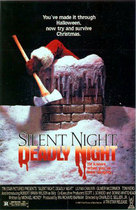Our editor-in-chief Nate Yapp is proud to have contributed to the new book Hidden Horror: A Celebration of 101 Underrated and Overlooked Fright Flicks, edited by Aaron Christensen. Another contributors include Anthony Timpone, B.J. Colangelo, Dave Alexander, Classic-Horror.com's own Robert C. Ring and John W. Bowen. Pick up a copy today from Amazon.com!
The Fearless Vampire Killers (1967)
It's a typical scene from a typical horror film: a vampire romances his unwilling victim before finally attacking them, leading to a chase sequence. Except in Roman Polanski's The Fearless Vampire Killers, the vampire is gay, the "damsel" is also the ostensible hero (and male), and the chase sequence involves slick floors that cause both pursuer and pursued to slide crazily as they run.
Another director might play up the slapstick of the sequence with exaggerated angles and silly sound effects. Polanski avoids such clichés, pointing his camera as a documentarian would, observing the behavior of comedy in the wild. There is an implicit acknowledgement that, yes, this is humor we're watching, but Polanski refuses to cajole us into accepting it as funny. That is our own decision to make.
While this almost scholarly regard for comedy is not apparent in all parts of the film, it is legion enough to affect the overall result of the film. The Fearless Vampire Killers often engenders admiration more than it does screams or laughs. Polanski is attempting to make an horror-comedy-art movie, and it's quite possible he succeeds, but at the cost of the visceral reactions that two out of the three genres require to function.
The plot has all the trappings necessary for madcap fun: two inept vampire killers (Jack MacGowran and Polanski himself) who can't seem to find vampires, a buxom beauty (Sharon Tate) so enamored of luxury that she never quite understands the danger she's in, and a passel of sophisticated bloodsuckers who are all far more intelligent than anyone else in the film. Toss in a Jewish vampire who chuckles when a crucifix is brandished at him ("Oy, hev you got the wrong vempire!") and you have enough of the right ingredients that any semi-competent director could toss together a nutty caper with laughs every other minute.
Polanski is more than simply competent, however, and takes the standard elements of comedy and repositions them in an unexpected fashion. Production design plays a huge part in this. Fearless Vampire Killers is set in winter, and the mise-en-scene reflects the cold, chapped nature of the weather and creates a feeling of being trapped in wide open plains. The snow that blankets everything imbues each frame with a sinister, faerie tale quality. These sensations are too bleak for comedy, but they play nicely into the horror elements. As dunderheaded as MacGowran and Polanski act, they would still be in grave danger were they competent, and it's difficult to ignore that.
Furthermore, the wintry setting helps to carry out the themes of isolation that Polanski explores throughout his career -- most notably in Repulsion and Rosemary's Baby, where the protagonists are alone, but also completely surrounded by destructive, evil forces. This particular concept is given visual representation in Fearless Vampire Killers at the end of the ballroom scene. Our heroes, having infiltrated the vampires' celebration, believe that they have gone completely unnoticed -- until the latest step plants them in front of mirror, where they are the only beings apparent, despite being surrounded by fiends.
Perhaps the artful, detached approach that Polanski takes for the majority of the film is his own attempt at reconciling the thrills and the laughs. By viewing the action from behind objectivity, he's asking us to choose which type of film we wish to see. Although the comedy elements are the most apparent, the horror tends to work better, at least in the way that Hammer horror films work (a similarity that can't be unintentional, since certain plot threads are open parodies of Kiss of the Vampire and Brides of Dracula).
Even with its lack of overt visceral reactions, Polanski's film tends to work despite itself. It's difficult not to appreciate the film for its quirky approach. Certainly, there is almost no slacking in any particular aspect of the filmmaking process (except the makeup, which never quite gels with the face to which it's applied). Everyone appears to get what Polanski's attempting, even if it's not always apparent what that is.
Often derided as little more than an interesting failure in Polanski's oeuvre, The Fearless Vampire Killers deserves a second glance. It's a striking, beautiful film that approaches both horror and humor in a manner to which they are unaccustomed. For that reason alone, it should be given at least one viewing.








